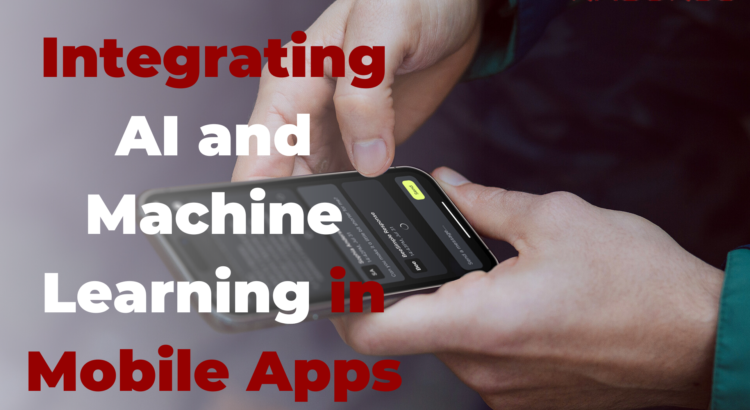Artificial Intelligence (AI) and Machine Learning (ML) have transitioned from theoretical concepts to transformative technologies that are revolutionizing various industries. Among these, mobile app development stands out as a domain experiencing significant disruption and enhancement due to the integration of AI and ML. This blog explores how integrating AI and ML in mobile apps is reshaping user experiences, driving innovation, and setting new standards for efficiency and functionality.
Understanding AI and ML
AI refers to the simulation of human intelligence in machines, enabling them to perform tasks that typically require human intelligence, such as visual perception, speech recognition, decision-making, and language translation. ML, a subset of AI, involves training algorithms on large datasets to enable them to make predictions or decisions without being explicitly programmed for each task.
The convergence of AI and ML in mobile apps is creating opportunities to deliver personalized, intelligent, and responsive user experiences. Here are the specific ways these technologies are being integrated into mobile apps and the benefits they bring.
Enhancing User Experience
- Personalization: AI and ML enable apps to learn from user behaviour and preferences, allowing for highly personalized experiences. For instance, streaming services like Netflix and Spotify use ML algorithms to analyse user data and recommend content tailored to individual tastes. Similarly, e-commerce apps leverage AI to provide personalized shopping experiences, suggesting products based on browsing history and purchase patterns.
- Natural Language Processing (NLP): NLP, a branch of AI, empowers mobile apps to understand and interpret human language. Voice assistants like Siri, Google Assistant, and Alexa utilize NLP to comprehend and respond to user commands, making interactions more natural and intuitive. Chatbots integrated into customer service apps use NLP to handle customer queries efficiently, providing instant support and enhancing user satisfaction.
- Image and Voice Recognition: AI-driven image and voice recognition technologies are revolutionizing how users interact with mobile apps. Apps like Google Photos use image recognition to categorize and search photos based on content, while voice recognition allows users to perform tasks hands-free, enhancing accessibility and convenience.
Driving Innovation and Efficiency
- Predictive Analytics: ML algorithms excel at analysing historical data to make predictions about future outcomes. In mobile apps, predictive analytics can forecast user behaviour, enabling proactive engagement strategies. For example, fitness apps can predict when users are likely to exercise and send timely reminders, while finance apps can anticipate spending patterns and provide budgeting advice.
- Automated Processes: AI and ML automate repetitive tasks, improving efficiency and freeing up resources for more strategic activities. In mobile banking apps, AI-powered algorithms can automate fraud detection by analysing transaction patterns and flagging suspicious activities in real-time. Similarly, in healthcare apps, ML can automate the analysis of medical records, aiding in faster diagnosis and treatment recommendations.
- Enhanced Security: Security is paramount in mobile app development, and AI plays a crucial role in fortifying it. ML algorithms can detect and respond to security threats by analysing patterns and identifying anomalies. Biometric authentication methods, such as facial recognition and fingerprint scanning, are enhanced by AI, providing robust security measures to protect user data.
Overcoming Challenges
While the integration of AI and ML in mobile apps offers numerous benefits, it also presents certain challenges that developers must address:
- Data Privacy and Security: AI and ML rely on vast amounts of data to function effectively. Ensuring the privacy and security of this data is crucial. Developers must implement stringent data protection measures and comply with regulations like GDPR to safeguard user information.
- Model Training and Maintenance: ML models require continuous training and updates to remain accurate and relevant. This necessitates ongoing data collection and processing, which can be resource-intensive. Developers need to establish efficient workflows for model training and maintenance to ensure optimal performance.
- User Trust and Transparency: Users need to trust that AI and ML technologies are being used ethically and transparently. Clear communication about how data is collected, processed, and utilized is essential to build and maintain user trust. Providing users with control over their data and offering opt-in/opt-out options can further enhance transparency.
Future Trends and Opportunities
The integration of AI and ML in mobile apps is an evolving landscape, with several emerging trends and opportunities on the horizon:
- Edge AI: Edge AI involves processing data on the device itself, rather than relying on cloud-based servers. This approach reduces latency, enhances data privacy, and improves real-time decision-making capabilities. With advancements in hardware, edge AI is becoming more feasible, enabling smarter and faster mobile apps.
- Explainable AI (XAI): As AI-driven decisions become more complex, the need for explainability is growing. XAI aims to make AI processes and outcomes understandable to humans. Integrating XAI into mobile apps can enhance user trust and provide insights into how AI-driven recommendations or actions are derived.
- Cross-Industry Applications: AI and ML are not confined to specific industries; their applications are expanding across various sectors. From healthcare and finance to education and entertainment, mobile apps in diverse domains are leveraging AI and ML to deliver innovative solutions and improve user experiences.
